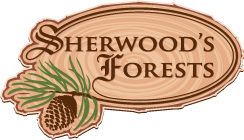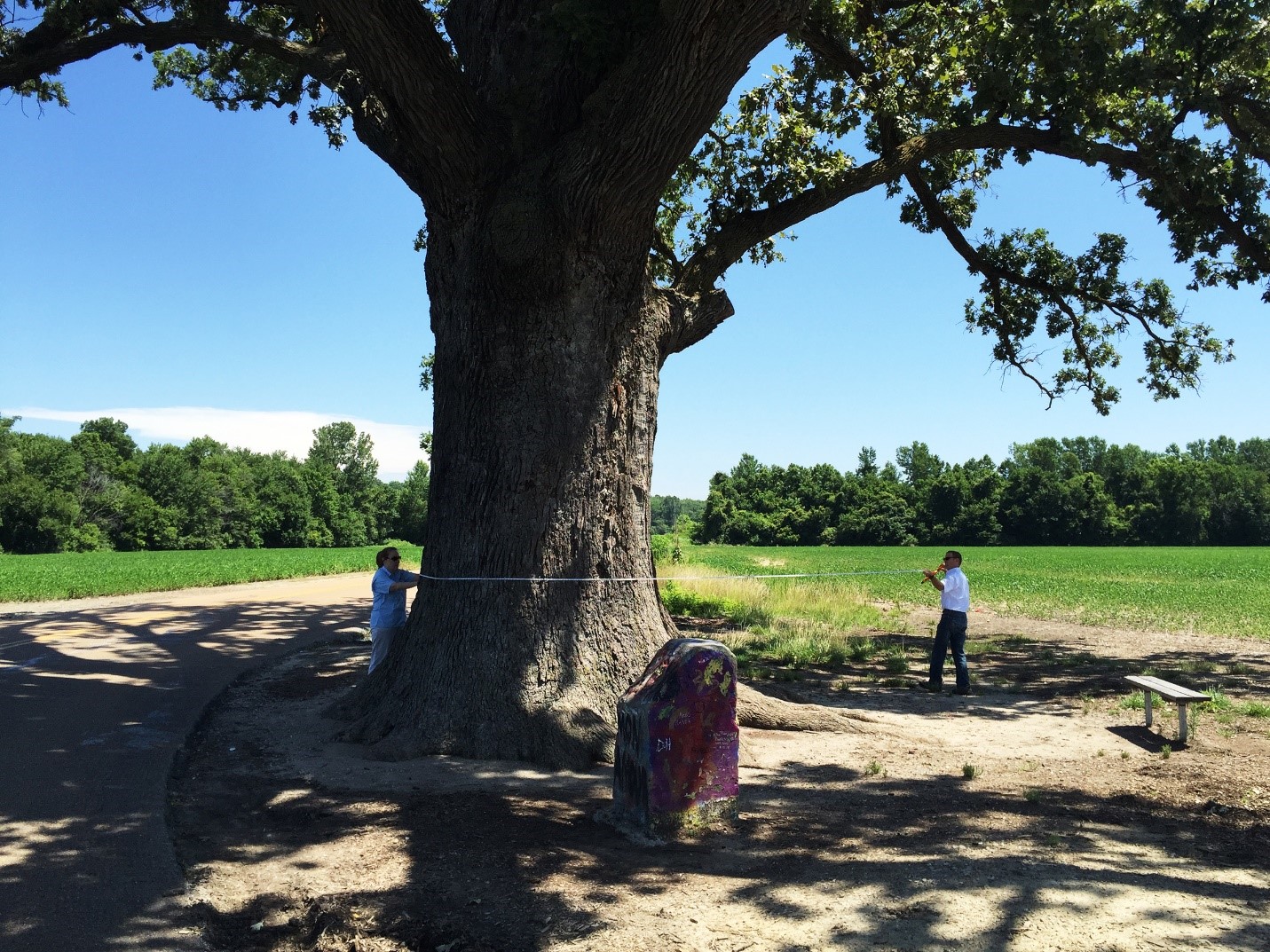
This one is in Missouri. This champion bur oak has a circumference of 295 inches, is 74 feet tall, and has a crown spread of 129 feet. Most don't get this big.
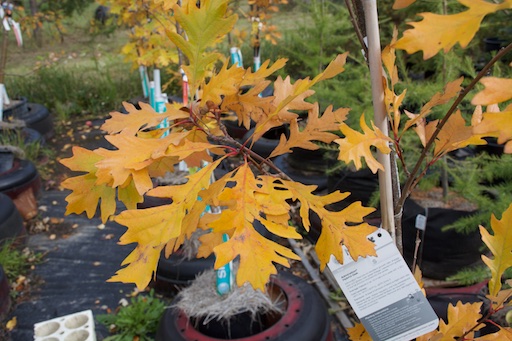
Admiration Oak branch.

When it gets mature, the bark breaks off in chunks, as the trunk inside expands. This isn't harmful to the tree.
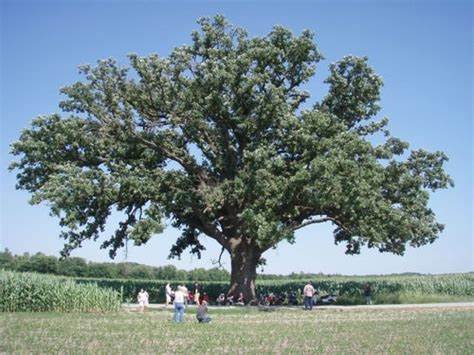
Another large example. You may think I have a thing for big trees. You'd be right.

Bur oak in my arboretum. Come for a visit. I'll introduce you.
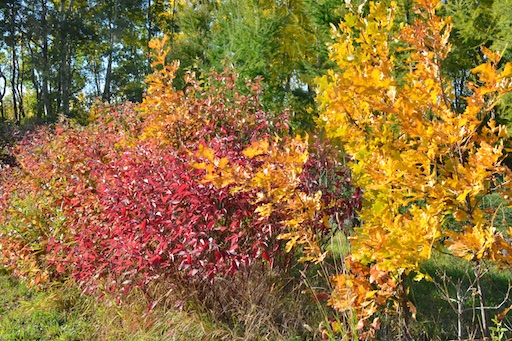
Dogwood (Red) are a good way to protect oak (Orange) from deer. Pack several dogwood around the base. Deer will go after the dogwood in preference to the oak.
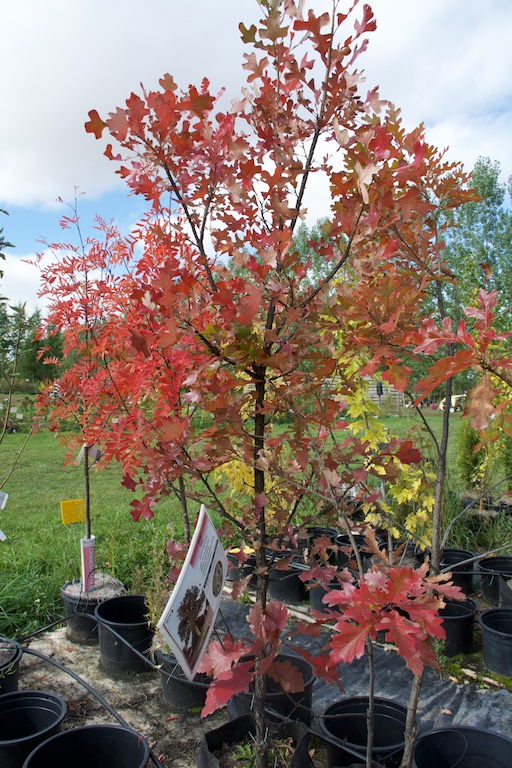
Colour is variable. Compare this to the oak above. Haven't figured out what makes for a red year.
Black Walnut Butternut
Oak & Walnut
Quercus & Juglans
These two species are lumped together for a variety of reasons:
- Both are slow growing.
- Both eventually get very large.
- Both have limited varieties.
- Both are shade tolerant.

Oaks
The oaks are broadly divided into "White Oaks" and "Red Oaks" It doesn't help that the archtypical example of each are White Oak and Red Oak.
The white oaks (note the 's') have round lobed leaves. Their acorns can germinate as soon as they hit the ground. Bur Oak and White Oak are the two I've run into locally. Fall colour in a good year is a dusty dark red. In a bad year, dishwater.
The red oaks have points on the lobes. Aside from the colour they look very goth. Red oaks often have spectacular fall colour.
White Oak
(The tree, not the group...) Fall colour is a dusty wine red. Nuts are up to an inch in diameter. Squirrels and blue jays love the acorns. This may be a feature or not. Does not tolerate wet soils. Does not transplant well from field grown due to taproot.
Bur Oak
This one is almost a native. Currently found in creek valleys in southern Saskatchewan, Manitoba, and a bit in SE Alberta. Gets to be large: up to 80 feet high, and the same wide. This means that one tree can not only shade your front yard, but also the street, and the neighbours on either side. Depending on long term relations with your neighbours this can be a good or a bad thing.
Bur oak is the best one for alkaline soils, actually does best in a somewhat alkaline soil. It tolerates mildly acid soils. It is often used as a root stock for fancier oaks.
Does NOT like salt.
More info: https://www.mortonarb.org/trees-plants/tree-plant-descriptions/bur-oak
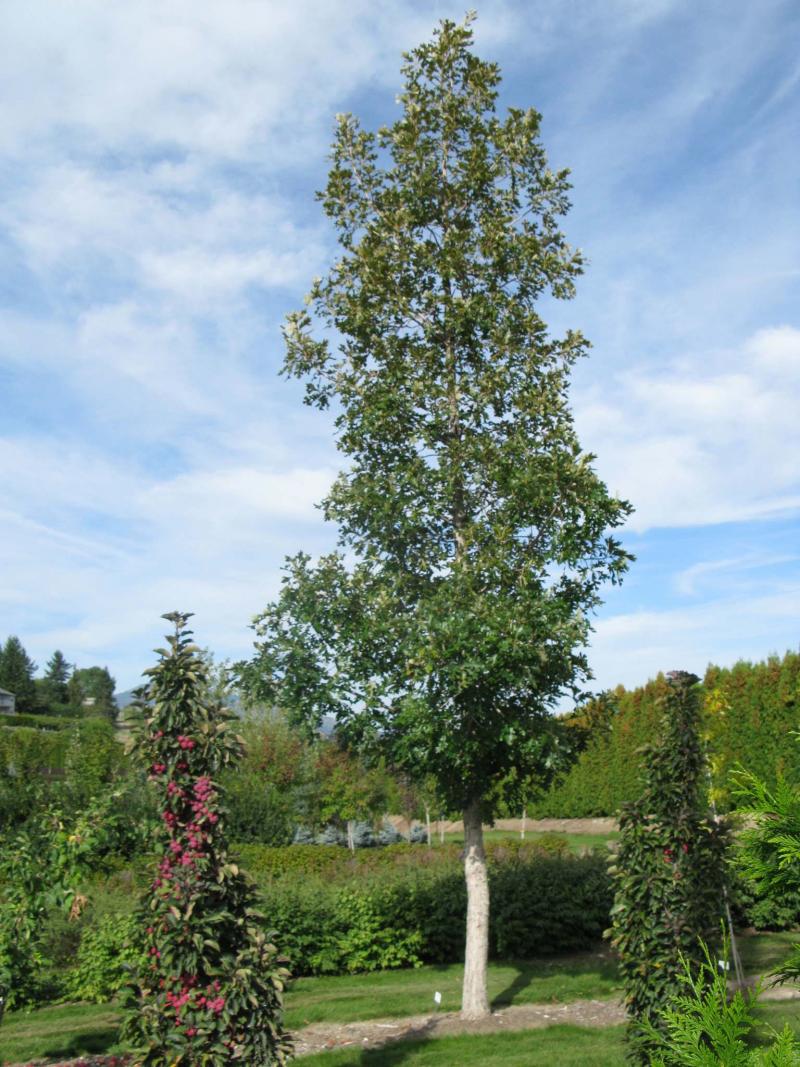
Top Gun Bur Oak. This cultivar has short branches. All it's energy is focused on getting taller.
'Top Gun' Bur Oak.
This is a columnar version that typically remains 4 times as tall as it is wide. Eventually will get to 65 feet tall x 15 feet wide.
'Admiration' hybrid oak.
This is a natural hybrid probably of white oak and swamp oak. Hardy to zone 2. Pyramidal crown. Shaggy bark. Leaves turn golden in fall, fading to a hot chocolate red/brown. Leaves can persist all winter on the tree. The parent tree is is probably going to be about 40 feet tall at maturity (in a suburb in Saskatoon). One of the aster oaks, it tolerates alkaline soil and is hardy to at least zone 2.
Growth pattern is pyramidal -- widest at the base and tapering upward. It's distributed on bur oak root stock.
Red oaks
Northern Red Oak
According to the Morden Arboretum, this oak should do well here. Zone 3, tolerates clay, alkaline soils. Mature height 60-75 feet. Tolerates some soil salt, acid soils. Pink leaves at bud break, russet to red in fall. One of the faster growing oaks. Haven't seen it sold here. Native to American midwest.
'Shooting Star' Northern Pin Oak
Leaves emerge brick red in spring. In fall they return to that brick red in fall. Grey bark and silver branches. 30-40 feet tall, 20+ feet wide. Tried one here in my demo garden. Didn't do well. I think it wants more water.
'Majestic Skies' Northern Pin Oak
Unlike many trees with 'sky' as part of the name, this is NOT one of the skinny ones. It does get big, however. 60 feet tall by 45 wide. Burgundy fall colour.
More info about oaks:
Acorns and Wildlife Habitat is a fascinating slide show (5-7 minute read) about the relationship and importance of oaks in forest ecologies in the Eastern Hardwood forests.

This, by all accounts is the more common colour: A rich slightly red brown.

You can expect to get a tree this size while you still own the house. Probably about 20 years old.
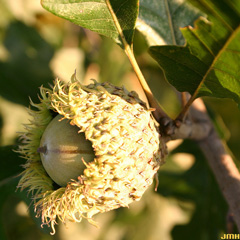
Acorn. Depending on the type of oak tree, acorns can be little -- the sizes of your little finger -- to big. Only three fitting on your palm. Most are 1/2" to 1" Caps can cover almost completely or barely hang on to the end of the nut.
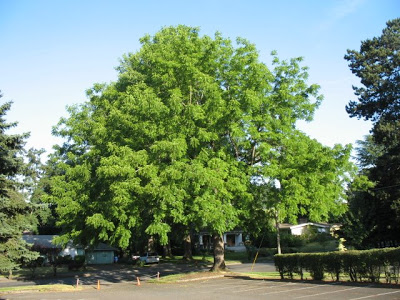
Mature tree. Like the oaks, they get big.
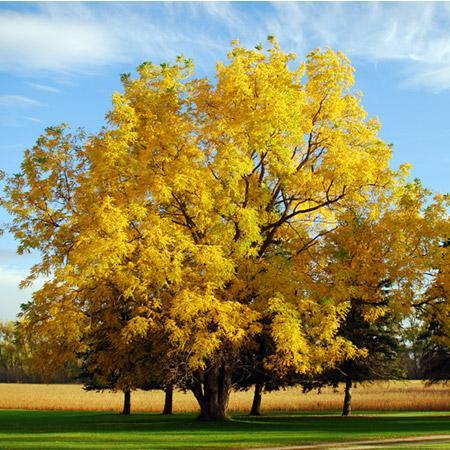
Fall colour isn't exceptional.
Walnuts
There are two members of this family that grow here.
Black Walnut
We are right at the edge of the zone for this one. Get your seed from a tree that grows in a cold area. This is a slow growing tree with really big pinnate leaves. The leaves are toxic to a lot of plants, and to horses. Takes 20 years to get nuts.
The nuts come in a greenish yellow rind about the size of a pool ball. Getting the nut out of the rind is easy: Grab with the palms of your hands and twist. Your hands will be black and blue for a week or so after from a pigment in the rind. Maybe wear gloves. The nuts are VERY hard, but are easier to open after a few weeks drying. They are smaller than the classic English walnut but have a stronger flavour.
Butternut
Butternuts have better cold tolerance. Superficially the trees are very similar looking. Butternuts are larger, and shaped more like footballs.
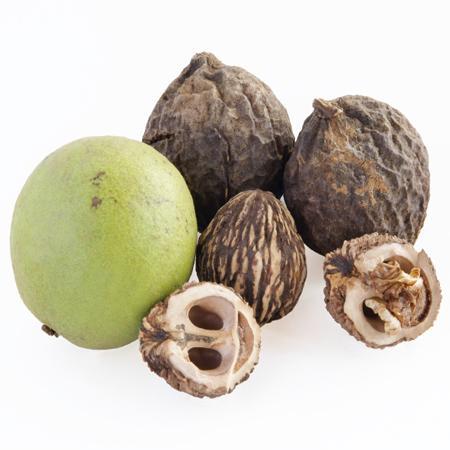
The green nut husk. Later they turn yellow, then black, much like a bananna.
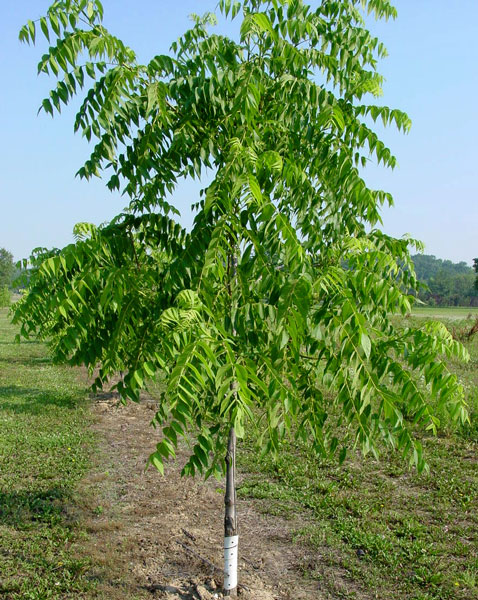
Young sapling tree. Not sure if this is a walnut or butternut.
As they get larger, they sprawl more.

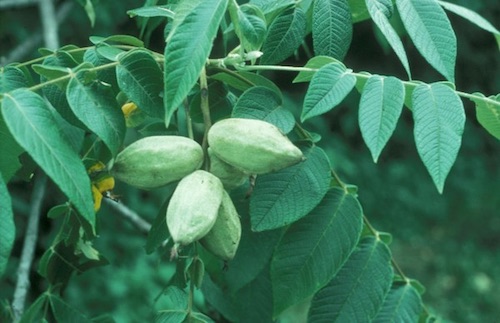
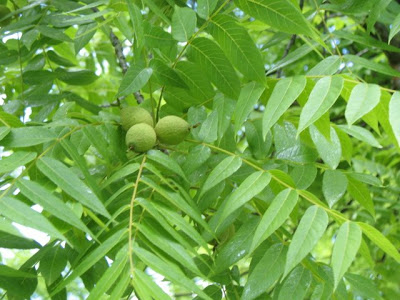
Inventory tables are double rows to make them usable on small screens.
Common name and container in column 1.
Count is how many we think we have left. Price is per tree.
Height will be there next year, we hope.
Leaf -- Oak
| Common Name Container |
Count Price |
Height (feet) |
|
| Oak, Admiration #10 Growbag (42 qt) |
4 $200.00 |
||
| Oak, Admiration #7 Std pot (21 qt) |
5 $140.00 |
||
| Oak, Bur #10 Growbag (42 qt) |
28 $160.00 |
||
| Oak, Bur #10 Growbag (42 qt) |
4 $175.00 |
||
| Oak, Bur #10 Growbag (42 qt) |
9 $200.00 |
||
| Oak, Bur #10 Growbag (42 qt) |
2 $225.00 |
||
| Oak, Bur #10 Std pot (30 qt) |
6 $160.00 |
||
| Oak, Bur #5 Std pot (15 qt) |
23 $90.00 |
||
| Last Update: 2024-Jan-21 | |||
Food -- Walnut
| Species Cultivar |
Container Format |
Available (# plants) |
Height (feet) |
Price ($/Plant) |
| Butternut, Common | #8 Std pot (24 qt) | 5 | 6-7 ft. | $90.00 |
| Last Update: 2020-Jan-20 | ||||
Got something to say? Email me: sfinfo@sherwoods-forests.com
Interesting? Share this page.
Want to talk right now? Call me: (8 am to 8 pm only, please) 1-780-848-2548
Do not arrive unannounced. Phone for an appointment. Why? See Contact & Hours That same page gives our hours of operation.
Back to Top
Copyright © 2008 - 2021 S. G. Botsford
Sherwood's Forests is located about 75 km southwest of Edmonton, Alberta. Please refer to the map on our Contact page for directions.
